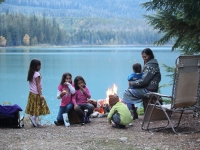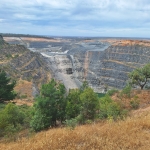Secwepemc Tribes Fight New Mines and Old Laws in British Columbia

Indigenous activists burned down a bridge in British Columbia, Canada, to prevent Imperial Metals from starting a lead and zinc mine on the lands of the Secwepemc peoples. Local tribes say that the mine may severely impact the one of the largest remaining sockeye salmon populations in the world.
Protests over the planned Ruddock Creek mine have been ongoing for several years. Judy Wilson, the chief of the Neskonlith tribe, attempted to serve an "eviction notice" on Imperial Metals this past August but the company insisted that it had authorization from the British Columbia Ministry of the Environment to continue exploration.
"These are our sacred headwaters where the glaciers meet and melt and have fed the creeks and rivers in our territory for thousands of years," a group calling itself Secwepemc Ts'ka7 Warriors that took responsibility for the fire, wrote in a press release. "It is where we hunt, it's where we harvest our food and our medicines. It is the birthing grounds for our water and our salmon."
"With much discussion with Elders Councils and around sacred fires and ceremonies, warriors have acted out their collective responsibility and jurisdiction to and in the Ts'ka7 area by deactivating the Imperial Metals Ruddock Creek Mine," the group added.
Conflict over the environmental impacts of natural resource extraction has long been a flashpoint in Canada where indigenous communities have struggled to protect traditional livelihoods like fishing.
Indeed, this is the third time that Imperial Metals has been in the news in the last three months over its exploration activities. In August, a dam broke at the company's Mount Polley copper and gold mine in central British Columbia causing five million cubic metres of wastewater to spill into Quesnel lake, in an area that is also claimed by the Neskonlith tribe. The same month, the company faced opposition from the Tahltan tribe which blockaded the Red Chris copper and gold mine in northwestern British Columbia.
Much of the conflict stems from British Columbia's antiquated "free entry" system that dates back 150 years to the Klondike Gold Rush. At the time, anyone could plant a physical stake in the ground to claim sub-surface mining rights. The claimant was then required to register it with the local authorities and "work" the claim within two years. In 2005, the physical claim staking was converted into an even easier online map staking process where anyone could pay $25 and $0.17 per acre to obtain mining rights. Over four years, the amount of land claimed skyrocketed from 1.1 million hectares to 5.2 million by 2008
While other Canadian provinces like Ontario have modified the free entry system to mandate seeking permission from the local tribes, tribes in British Columbia have faced a much more difficult time to get their traditional land rights recognized by the provincial government.
Environmental groups have supported the fight against the Ruddock Creek mine. Ramsey Hart, Canada program coordinator of MiningWatch Canada, has asked the federal government to step in and assess the environmental impact.
"In general, we think the federal government has an important role to play for a number of reasons. They have the expertise and the independence from the on-the-ground politics," Hart told Kamloops This Week, noting that the company should be prepared for a long fight. "When you ignore the rights of concerns of First Nations, it's a good recipe for delays, review and legal cases."
- 183 Environment



